Vireya
rhododendrons
Known for their brilliant
colour, vireyas are the star of the rhododendron family, often flowering
all year round.
 Imagine
the surprise, and even delight, on the faces of English botanists
and gardeners when expeditions returned from Malaya and Indonesia
in the mid-nineteenth century with a new group of rhododendrons
that flowered nearly all year round. Imagine
the surprise, and even delight, on the faces of English botanists
and gardeners when expeditions returned from Malaya and Indonesia
in the mid-nineteenth century with a new group of rhododendrons
that flowered nearly all year round.
They were well familiar
with "traditional" rhododendrons which fell mainly into two groups
— those we know as the deciduous azalea, and the large, cold-hardy,
spring-flowering evergreen types.
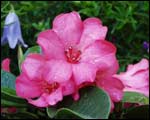 These
new "East Indian" rhododendrons were seemingly very different from
the familiar types — they needed a heated greenhouse, they
were frost tender, they knew no season and flowered all the year
round. The only thing in common seemed to be their need for regular
moisture and an acid soil. These
new "East Indian" rhododendrons were seemingly very different from
the familiar types — they needed a heated greenhouse, they
were frost tender, they knew no season and flowered all the year
round. The only thing in common seemed to be their need for regular
moisture and an acid soil.
We now know the "East
Indian" types as Vireya rhododendrons after the French pharmacist
and natural historian Julien Joseph Virey. They have their origins
in the area that extends from Malaya to the Philippines and from
Indonesia to Papua New Guinea.
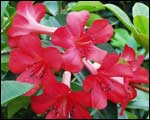 In
their natural habitat they thrive in dappled sunshine and high light
conditions and moist surroundings. They're seldom found growing
on the forest floor — it's too dark. Most often they're growing
happily in the leaf litter that's collected in the bough of a larger
tree high above the ground, or at ground level on the edge of a
forest clearing, or along a road cutting. In
their natural habitat they thrive in dappled sunshine and high light
conditions and moist surroundings. They're seldom found growing
on the forest floor — it's too dark. Most often they're growing
happily in the leaf litter that's collected in the bough of a larger
tree high above the ground, or at ground level on the edge of a
forest clearing, or along a road cutting.
Known for their brilliant
colour, the flowers come in varying sizes, but are typically set
in clusters and tube-shaped — some narrow and deep, others
quite large and shallow. They'll flower at almost any time of year,
up to three to four times a year for six to eight weeks at a time.
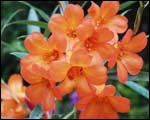 Most
grow to form open bushes with a distinctive 'twiggy' habit. Indeed
when we first grew vireyas in the late 1980s, many gardeners were
less than impressed with their habit. They are so different from
the large, cold-hardy, spring-flowering evergreen types. This concern
is now gone and a wide range of Vireya rhododendrons are enjoyed
for their colour, freedom of flowering and open habits. Most
grow to form open bushes with a distinctive 'twiggy' habit. Indeed
when we first grew vireyas in the late 1980s, many gardeners were
less than impressed with their habit. They are so different from
the large, cold-hardy, spring-flowering evergreen types. This concern
is now gone and a wide range of Vireya rhododendrons are enjoyed
for their colour, freedom of flowering and open habits.
Use vireyas anywhere
— in the garden, under eaves, in containers, patio pots and
conservatories. Some of the scrambling varieties can even be used
in a low basket.
In the garden, vireyas
need similar conditions to evergreen azalea — good light levels
and full sun to dappled shade (though some protection against summer's
burning sun is beneficial). Strong wind will knock them around,
and protection from all but the lightest frost is essential.
Colours
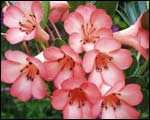 Many
Vireya rhododendrons come in gorgeous reds, such as 'Fireplum',
and bright oranges, such as 'Cordial Orange', but there are some,
like 'Luraluense', which have white flowers. 'Luraluense' also possesses
a noticeable perfume, which is another exciting characteristic of
some vireyas. Catch of whiff of 'Great Scentsation' and you'll see
what we mean! Many
Vireya rhododendrons come in gorgeous reds, such as 'Fireplum',
and bright oranges, such as 'Cordial Orange', but there are some,
like 'Luraluense', which have white flowers. 'Luraluense' also possesses
a noticeable perfume, which is another exciting characteristic of
some vireyas. Catch of whiff of 'Great Scentsation' and you'll see
what we mean!
Saxon Glow and Saxon
Blush are two very novel Vireya rhododendrons. Saxon Glow, with
its sensational red flowers, and Saxon Blush, with apricot flowers
and a flare of coral red on petal margins, were bred by crossing
a rare, compact — almost groundcover — species with the
more familiar open forms.
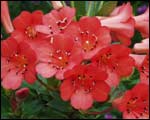 The
resulting habit is how they differ from other vireyas. They're compact
with very short internodes — the distance between leaves on
the stem. This makes for a dense bush, avoiding the open, and sometimes
leggy, look of other vireyas. The
resulting habit is how they differ from other vireyas. They're compact
with very short internodes — the distance between leaves on
the stem. This makes for a dense bush, avoiding the open, and sometimes
leggy, look of other vireyas.
Saxon Blush grows just
40 cm high, while Saxon Glow is a little taller, 60cm. Both are
easy-care evergreens, ideal for patio pots, garden beds and conservatories.
Using Vireya Rhododendrons
- Use anywhere for a
stunning burst of colour. Several different varieties planted
in a clump will almost certainly produce all year round flowers.
- In gardens and rockeries
— remember they do best in a freely drained soil.
- Patio pots and tub
gardens. Don't overpot, though. They like a "lean" root zone.
- In colder areas, pots
offer an additional advantage — they can be moved to provide
winter shelter.
- If you've not got
a conservatory, Vireya rhododendrons provide a great excuse —
start building today!
Growing Vireya Rhododendrons
Vireyas are pretty tolerant
plants, but here are a few tips that help plants thrive not just
survive!
- Plant in full sun
to dappled shade — but it helps if there is some shelter
from the harshest of summer sun.
- An open soil is best;
they need excellent drainage. Wet feet is often the main reason
for poor growth, weak flowering and death. Heavier soils can be
made more friable by incorporating compost and gypsum.
- Having said the above,
they do need adequate moisture. Try not to let them dry out. Mulch
to help conserve moisture.
- A feed with a slow
release fertiliser (8-9 month) early spring will provide tucker
for the spring and summer growing season. Avoid using lime; vireyas
prefer acid soils.
- Natural legginess
can be discouraged by pinching out every second growth flush.
- Like azalea, vireyas
are subject to the odd insect attack. Keep an eye out for tell-tale
signs — curled leaves, leaves with holes, etc, and seek advice
from you local garden centre.

Reproduced
with permission from NZOOM Home and Garden content,
from the previous
website of 
The views expressed here are not necessarily those of the RNZIH
 |
|
HOME
AND GARDEN |
|
|
More
Garden Articles
|


 Imagine
the surprise, and even delight, on the faces of English botanists
and gardeners when expeditions returned from Malaya and Indonesia
in the mid-nineteenth century with a new group of rhododendrons
that flowered nearly all year round.
Imagine
the surprise, and even delight, on the faces of English botanists
and gardeners when expeditions returned from Malaya and Indonesia
in the mid-nineteenth century with a new group of rhododendrons
that flowered nearly all year round.  These
new "East Indian" rhododendrons were seemingly very different from
the familiar types — they needed a heated greenhouse, they
were frost tender, they knew no season and flowered all the year
round. The only thing in common seemed to be their need for regular
moisture and an acid soil.
These
new "East Indian" rhododendrons were seemingly very different from
the familiar types — they needed a heated greenhouse, they
were frost tender, they knew no season and flowered all the year
round. The only thing in common seemed to be their need for regular
moisture and an acid soil.  In
their natural habitat they thrive in dappled sunshine and high light
conditions and moist surroundings. They're seldom found growing
on the forest floor — it's too dark. Most often they're growing
happily in the leaf litter that's collected in the bough of a larger
tree high above the ground, or at ground level on the edge of a
forest clearing, or along a road cutting.
In
their natural habitat they thrive in dappled sunshine and high light
conditions and moist surroundings. They're seldom found growing
on the forest floor — it's too dark. Most often they're growing
happily in the leaf litter that's collected in the bough of a larger
tree high above the ground, or at ground level on the edge of a
forest clearing, or along a road cutting.  Most
grow to form open bushes with a distinctive 'twiggy' habit. Indeed
when we first grew vireyas in the late 1980s, many gardeners were
less than impressed with their habit. They are so different from
the large, cold-hardy, spring-flowering evergreen types. This concern
is now gone and a wide range of Vireya rhododendrons are enjoyed
for their colour, freedom of flowering and open habits.
Most
grow to form open bushes with a distinctive 'twiggy' habit. Indeed
when we first grew vireyas in the late 1980s, many gardeners were
less than impressed with their habit. They are so different from
the large, cold-hardy, spring-flowering evergreen types. This concern
is now gone and a wide range of Vireya rhododendrons are enjoyed
for their colour, freedom of flowering and open habits.  Many
Vireya rhododendrons come in gorgeous reds, such as 'Fireplum',
and bright oranges, such as 'Cordial Orange', but there are some,
like 'Luraluense', which have white flowers. 'Luraluense' also possesses
a noticeable perfume, which is another exciting characteristic of
some vireyas. Catch of whiff of 'Great Scentsation' and you'll see
what we mean!
Many
Vireya rhododendrons come in gorgeous reds, such as 'Fireplum',
and bright oranges, such as 'Cordial Orange', but there are some,
like 'Luraluense', which have white flowers. 'Luraluense' also possesses
a noticeable perfume, which is another exciting characteristic of
some vireyas. Catch of whiff of 'Great Scentsation' and you'll see
what we mean!  The
resulting habit is how they differ from other vireyas. They're compact
with very short internodes — the distance between leaves on
the stem. This makes for a dense bush, avoiding the open, and sometimes
leggy, look of other vireyas.
The
resulting habit is how they differ from other vireyas. They're compact
with very short internodes — the distance between leaves on
the stem. This makes for a dense bush, avoiding the open, and sometimes
leggy, look of other vireyas. 